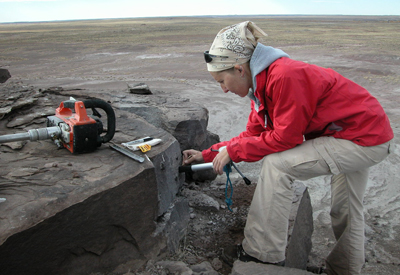Kate Zeigler, Ph.D.

Drilling core samples in the Petrified Forest National Park
Kate Zeigler, Ph.D.
Postdoctoral Research Scientist – Geology
Dr. Zeigler was born in Butte, Montana and grew up in Houston, Texas. In spite of the immense difference in climate and culture, she has always been obsessed with rocks and fossils. When she was very small, she really wanted to be a triceratops until her folks convinced her that was not an option. She attended Rice University and obtained a B.A. in geology and anthropology, then went on to receive her M.S. and Ph.D. from the University of New Mexico. Her master’s thesis research explored the taphonomy of a vertebrate death assemblage near Ghost Ranch, New Mexico. By examining the types of creatures preserved, their relative ages (juvenile v. adult) and other features preserved in the outcrop, she was able to determine that the most likely cause of this mass mortality event was a wildfire! However, she decided she wanted to do more than just look at bones and so her dissertation research focused on trying to refine our understanding of time in the Late Triassic — when did certain events happen in different places? In order to do this, she climbed the steep learning curve of paleomagnetism and developed the first nearly complete magnetostratigraphy for the Chinle Group. The majority of the rocks that form Chinle strata in the American Southwest are mudrocks and had not been studied in previous research on paleomagnetism and magnetostratigraphy in rocks of Late Triassic Age. Working on these strata is beginning to clarify our understanding of when different events occurred around the broader Chinle Basin and has certainly made it clear that deposition in an aggradational basin is very complex! She is currently running her own geologic consulting company (ZGC: zeiglergeo.com) and has been teaching part-time at the University of New Mexico. She works for the N.M. Bureau of Geology and Mineral Resource’s State Map program and has worked on multiple 7.5′ quadrangles around the state. She is also working on developing a more complete magnetostratigraphy for Upper Triassic strata at the Petrified Forest National Park in Arizona, in addition to beginning a postdoctoral fellowship at Highlands in August of 2011. The focus of her postdoctoral research, as well as a separate project for Union County in northeastern New Mexico, is understanding the Ogallala Formation in terms of timing of deposition. We hope to contribute to a better understanding of this unit, as it is a critical aquifer for the Great Plains. Zeigler hopes to continue to contribute to ongoing developments in our understanding of complex depositional systems using magnetostratigraphic data.
